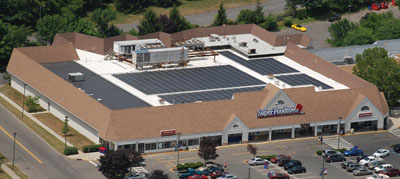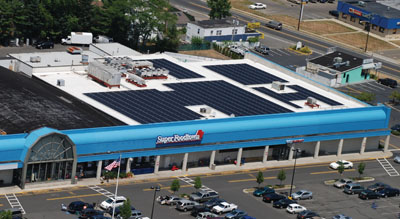Solis Partners
The primary obstacle to commercial solar deployment is the roof itself: Not all rooftops are solar ready.
Mark Norkus, the vice president of a family-owned company, Norkus Foodtown, is a forward thinker who wanted to deploy solar on the rooftops of six Foodtown supermarkets in Monmouth and Ocean Counties, New Jersey. His motivation was simple: Because the lights and refrigerators in a supermarket run 24/7, electricity is his biggest expense after inventory, labor and real estate.
 But Norkus’ efforts to cut electricity bills through the use of solar were frustrated by the fact that only three Norkus stores were found to have roofs strong enough to support traditional flat, glass-plated “crystalline” solar panels. What’s more, because the panels, which are tilted to 10 to 15 degrees to maximize exposure to the sun, become natural sails in strong coastal winds, they would have to be heavily ballasted, requiring further structural reinforcement and roof remediation.
But Norkus’ efforts to cut electricity bills through the use of solar were frustrated by the fact that only three Norkus stores were found to have roofs strong enough to support traditional flat, glass-plated “crystalline” solar panels. What’s more, because the panels, which are tilted to 10 to 15 degrees to maximize exposure to the sun, become natural sails in strong coastal winds, they would have to be heavily ballasted, requiring further structural reinforcement and roof remediation.
The cost of reinforcing the roof increased the expense to the point that solar no longer made sense, despite liberal state and federal financial incentives. Or so Norkus thought.
When most people think of solar, they think of arrays of panels blanketing the desert floor or an expanse of prairie. But New Jersey has become a national leader in solar installations (second only to California) on the basis primarily of rooftop solar installations on large commercial and industrial buildings. As a major distribution center at the heart of one of the world’s largest consumer markets, as well as one of the nation’s most heavily industrialized states, New Jersey has a wealth of large commercial and industrial buildings that can be tapped for solar. In fact, New Jersey has one of the highest concentrations of commercial roofs per square mile in the United States.
In terms of its solar potential, New Jersey is “the nation’s Saudi Arabia of rooftops,” in the words of a state energy official.
 Installing rooftop solar offers tremendous benefits. In addition to the societal benefits of reducing harmful greenhouse gas emissions and reliance on foreign oil, rooftop solar turns an underutilized asset into a source of clean, renewable on-site energy and creates a new revenue stream in the form of SRECs (Solar Renewable Energy Certificates), which are generous state incentives designed to promote the development of alternative sources of energy. In addition, the upfront cost of solar is becoming increasingly affordable thanks to federal incentives such as a Treasury Grant Program that covers 30% of the cost, accelerated tax depreciation and various financing alternatives.
Installing rooftop solar offers tremendous benefits. In addition to the societal benefits of reducing harmful greenhouse gas emissions and reliance on foreign oil, rooftop solar turns an underutilized asset into a source of clean, renewable on-site energy and creates a new revenue stream in the form of SRECs (Solar Renewable Energy Certificates), which are generous state incentives designed to promote the development of alternative sources of energy. In addition, the upfront cost of solar is becoming increasingly affordable thanks to federal incentives such as a Treasury Grant Program that covers 30% of the cost, accelerated tax depreciation and various financing alternatives.
The trouble is — as Mark Norkus discovered — not all commercial rooftops are suitable for solar. In fact, according to a recent article in Solar Industry magazine, 75% or more of big box warehouse and industrial buildings in some markets may be unsuitable for rooftop solar because their structures cannot support the weight. Traditional solar panels can add 6 to 8 pounds per square foot to roof loads once racking, ballast and other components are figured in. The inability to handle the extra weight is particularly true of buildings built prior to 1997, when building codes became more stringent, according to Solar Industry. Indeed, because additional structural capacity adds to cost, most buildings, including those built after 1997, are constructed with little or no excess capacity, with the result that they must be evaluated for solar on a case-by-case basis.
Fortunately, new, lighter solar technologies have become available that can be used on a broader range of commercial rooftops. These include a revolutionary new cylindrical solar technology designed specifically for commercial rooftops. These particular panels weigh half as much as traditional crystalline panels and are more efficient as well, collecting direct, reflected and diffused light across a 360-degree solar photovoltaic surface. In addition, unlike traditional solar panels, which utilize racking systems that require the use of heavy ballast or roof penetrations, these panels are self-ballasted, resulting in lower weight and less stress on the roof system. In fact, the panels are rated to tolerate wind speeds of up to 134 miles per hour.
The availability of this lighter-weight technology helped Norkus realize his dream of installing solar at all six Norkus Foodtown stores, where they will provide a clean, low-cost source of power for 25 years or more. Although traditional panels could have been used at three of the stores, Norkus chose to deploy the same new technology at all six, thus achieving a higher output of electricity. The systems on the six buildings are expected to produce more than 600,000 kilowatt-hours of electricity in the first year, or about 5% of the power needed. The solar technology was installed along with a new white TPO (ThermoPlastic Olefin) “cool” roof, which, in addition to contributing to increased solar output, also helps reduce air conditioning costs by about 20% by keeping the stores cooler during the summer. The payback period for the entire system — including panels, installation and roof — is less than 7 years.
When presented with the benefits of solar, the reaction of many commercial building owners is: “This sounds too good to be true.” Although the benefits of solar are unquestionable, the only black mark in this otherwise rosy picture is the unsuitability of many commercial rooftops for traditional solar installations. With the availability of the new, lighter technologies, many more New Jersey commercial and industrial rooftops will be able to host rooftop solar systems, helping to transform the commercial and industrial rooftops of the Garden State into a solar powerhouse.
—Jamie Hahn is managing director of Manasquan, New Jersey-based Solis Partners, a leading integrator of Solyndra solar technology.
